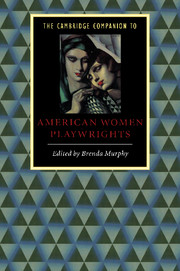2 - Women writing melodrama
from Part 1 - Pioneers
Published online by Cambridge University Press: 28 May 2006
Summary
From Mary Carr Clarke’s early play The Benevolent Lawyers; or Villainy Detected (1823), to the many successful novel adaptations by the prolific Louisa Medina, to Pauline Hopkins’ Slaves’ Escape; or the Underground Railroad (1880), to the widely varied work of Francis Hodgson Burnett, whose stage adaptations of her own novels span several decades, American women have been writing melodrama. These women, and others like them, played an important role in the development and success of the mode of drama that had the greatest impact on the American theatre in the nineteenth century.
The study of nineteenth-century melodrama has traditionally been on the fringes of scholarly work. This is due in large part to the concerted efforts of early twentieth-century theatre practitioners to create new forms completely divorced from melodrama, which by that time had held the stage for nearly a century. The writers and producers of the new styles of realism, naturalism, and symbolism had to slay the giant of melodrama in order to gain control of the theatre of the twentieth century. Writers such as George Bernard Shaw, Eugene O’Neill, Anton Chekhov, and Susan Glaspell began writing plays that demanded new acting and production styles. These writers, as well as designers, theorists, and producers, were passionate in their defense of a new aesthetic for the theatre and their arguments against melodrama gained in strength and validity as the old mode of communication failed to respond to the new age. Eventually scholars and practitioners began to speak with scorn of anything thought to be melodramatic, as they simultaneously spoke glowingly of all efforts to create a sense of realism.
- Type
- Chapter
- Information
- The Cambridge Companion to American Women Playwrights , pp. 19 - 30Publisher: Cambridge University PressPrint publication year: 1999



